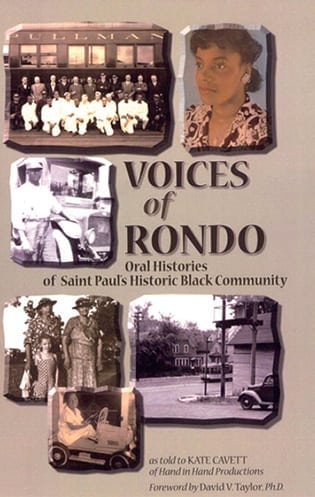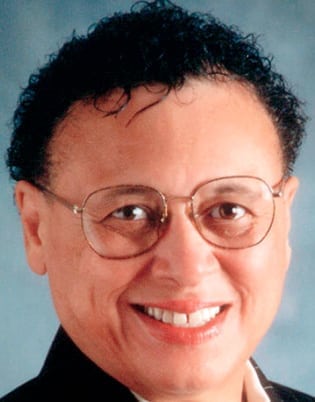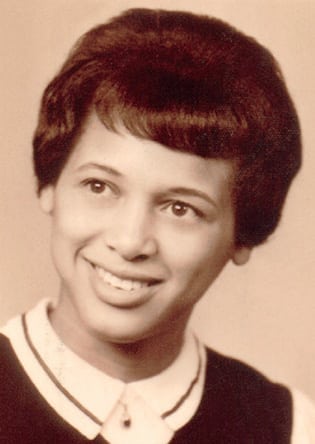 Oral history is the spoken word in print. Oral histories are personal
Oral history is the spoken word in print. Oral histories are personal
memories shared from the perspective of the narrator. By
means of recorded interviews, oral histories collect spoken memories
and personal commentaries of historical
significance. These interviews are transcribed
verbatim and minimally edited for readability.
The greatest appreciation is gained when one
can read an oral history aloud.
—Kate Cavett, oral historian,
HAND in HAND Productions
The following oral history is excerpted from
Voices of Rondo: Oral Histories of Saint Paul’s
Historic Black Community and is used by permission.
Voices of Rondo won a 2006 Minnesota
Book Award.

Courtesy Kate Cavett
My name is Debbie Gilbreath Montgomery.
I grew up at 978 Saint Anthony, which
is on the corner of Saint Anthony and
Chatsworth. I was adopted by my grandparents,
Isabella Gertrude Gilbreath,
whom I called Mama, and Elbert Gilbreath,
whom I called Dad.
Back then our neighborhood was a village.
If you did something wrong or said
something out of line or didn’t respect your
elders, you were going to be disciplined.
You probably got lickings before you got
home, and then when you got home you got another one. So it was
a strong village environment, and everybody looked out for each
other’s family. If you needed something, you could holler across the
street. If you needed a couple of eggs, or some milk, everybody kind
of shared, Whites and Blacks together. It was a really close-knit
community. It was a really loving community. People cared about
you. They were concerned about your success.
Oxford Playground was a block away from our house. Back then
it was a swamp. Bill Peterson was a twenty-one-year-old Marine
who had just got out of the service. And he’s got this playground
that was a swamp. All it had on it was a little old warming house
along with a merry-go-round and six swings. Here he’s got all these
little Black kids and a few White kids and he’s sitting down there
trying to teach us how to play ball. We learned how to play T-ball
and softball and baseball.
I was a jock. I was very athletic and had a lot of energy. I was a
little wiry thing. Down at Oxford, you had Dave Winfield and Paul
Molitor. Bill Peterson was the baseball coach of the boys’ Attucks
Brooks–Legion All-State baseball team. Paul Molitor and Dave
Winfield and all those guys, they all played on those teams, and
they all came through Oxford.
Because it was a swamp and the field was not real good, nobody
would come out and scrimmage our girls’ team. A lot of the other
rec centers wouldn’t come and play us in our park because we
didn’t have a good field, so all of our games were away and a lot of
our parents didn’t have cars. The girls’ softball team would scrimmage
the boys’ Attucks Brooks baseball team. Dave Winfield was
the pitcher then and Paul was shortstop. We’d all be playing ball,
and these guys were throwing that ball in there like they were
throwing to guys! Anyway, I ended up being one heck of a softball
player. I’d hit the ball Dave was pitching, and I’d just cream it! To
this day, David’ll say, “Boy, she just killed my pitches!” I was a good
softball and basketball player and I ran track. I was a speed skater.
In the wintertime, Bill would get out there and flood this area
for us to skate on. He just kept us engaged. Then he’d go out and
beg, borrow, and steal skates so we all could skate. I must have had
the biggest feet, because I ended up getting black speed skates. The
other girls had white figure skates and the boys had hockey skates.
For the Winter Carnival, they would always have the races out
at Como Park, and so he’d put all of us in his little red 1954 station
wagon and drag us out to Como. We’d get out there, and I didn’t
know how to speed skate when I first started, so I literally outran
people around the ice on these speed skates. Finally, they took an
interest in me and saw that I had potential, and Bill got a couple
of guys to work with me, to try to teach me how to stride and how
to skate. I became really, really good. I got all kinds of blue ribbon
medals from skating at the Winter Carnival. I beat Mary Meyers,
who tied for the 1968 silver medal, two out of three heats in the
tryouts.
They had two speed skating clubs that were close to us. The
Blue Line Speed Skating Club, which was kind of a high-buck private
speed skating club on this side of town, and East Side Shop
Pond, over on the East Side. Because the Blue Line Club was over
here, Bill took me over to try out for the club, but they weren’t letting
any Black kids in. The East Side Shop Pond would take me in
the club, but we didn’t have any transportation to get there. To this
day, Peterson says, “What could you have done if you had had any
kind of training?” I was obviously an athlete before my time.
There were so many things going on back then in the 1960s, that
skating wasn’t an important deal. The sports part was secondary
to people getting the right to vote. You know, we didn’t get the voting
rights bill in until 1965. We didn’t get open housing in Saint Paul
until 1960. So there were just tons of issues back then, and sports
was an outlet for me. It felt good to succeed, but I never dwelled
very much on “this is an opportunity missed.”
When I was maybe thirteen, Allie May Hampton was a good
friend of mine, and when I say friend, she was an older woman that
was real active in the NAACP. She was just a gem. She saw I was a
rabble-rouser and intelligent and articulate, and she got me active
in the NAACP. She was getting us involved in the political process,
getting us to understand the issues that were going on back then.
This was in the late ’50s, early ’60s. She took me to my first NAACP
conference. After I came back from the conference, they made me
the president of the youth group.
I got all the kids involved in the NAACP youth group. We had 650
kids in it back then, because we had tons of kids and there were
a lot of issues going on. I got really involved with the civil rights
movement after that first conference and meeting all the kids
from the South and the East and the West. Listening to what was
going on down South, none of that was going on here like it was in
the South. Our schools were integrated.
When the civil rights movement started they had buses going
down to Mississippi and Alabama. In Minnesota, we were good for
sending White activists down, and I was one of the Black youth
that went down there.
Mama was scared to death because she was from Starkville,
Kentucky, and Dad was from Lubbock, Texas, so they knew about
the South. I didn’t have a clue about what was going on, other than
I knew I was fighting for a cause, and not realizing that people were
killing people. I mean, I did realize it, but I didn’t think it could happen
to me.
I went on the bus with a lot of White kids and White adults and a
few civil rights folks, and we got down there and we demonstrated
and then got on a bus and came back. We were fighting for voting
rights. I was probably about fifteen then. My parents were just
scared to death, but I was just kind of a freewheeling kid. “I gotta
go do the right thing for the right reason.”
I became involved in the NAACP youth branch at the national
level. We had to go down to Chicago, Atlanta, or Baltimore for
conferences. Dad, he’d get me a pass and put me on the train. Dad
and Mama never rode the train in their whole life, but because
Dad worked with the railroad they could get passes. He’d take me
down to the depot. He’d hook me up with a porter, one of his porter
friends, and the porter would put me on the train. They’d usually
put me in the food car because they could feed me there and make
sure I was taken care of. Then when I got to Chicago and had to
transfer, they’d take me by the hand and take me to another train
and hand me over to another porter and say, “This is Gil’s daughter.
She’s on her way to Baltimore, and she’ll be comin’ back at suchand-
such a time. If you’re on the train back, tell ’er where to meet
you when you let ’er off. Let ’er know that you’ll pick ’er up when
she comes back.”

Courtesy Kate Cavett
When I was seventeen I was elected
to the National Board of Directors for
the NAACP. As I said, at fifteen and sixteen,
I had gotten really active in the
national youth movement, so I made
friends with the children of the national
NAACP leaders. I was just a rabblerouser.
We were all active in the national
youth movement, and so they’re telling
their dads, “Oh, man! She’s neat, man.
She’s smart. She’s articulate. She’s from
Minnesota.” They thought Minnesota was off the world. So the kids
got together at the national youth branch and said to me, “We’re
going to run you for the national board.” They got together and they
rallied all the kids together, and they got their parents together.
If you look at the NAACP history you’ll see that at the age of
seventeen, I ran nationally, at large. I got elected to the national
board of directors, with Roy Wilkins. I mean, all of the people that
you see in there, and here’s this little seventeen-year-old girl out of
Minnesota that’s sitting at the board with all these big shots.
I was on a mission. I was fighting for civil rights. I was speaking
up for people. Trying to get voting rights for the people. I mean,
these Black folks, they were in the army, they were serving their
country and yet they didn’t have the right to vote? If you look at
the history, Blacks were on the front lines and getting killed in
larger numbers, and they didn’t have the right to vote. They didn’t
have the right to own property. They had the poorest jobs.
On the national board it was interesting to listen to the discussions.
I mean, you had lawyers, bankers, politicians. You had lawyers
that were talking about legal issues. Thurgood Marshall, how
he was going to deal with the legal issues taken to the Supreme
Court. What’s going on in Missouri? What’s going on in Kansas?
They had huge issues, and you’re sitting there and you’re listening
to the discussion and listening to how they’re going to handle it,
who they were going to target. They were killing young people that
were going down there in cars, similar to what I was doing.
I was kind of blessed. I marched from Selma to Montgomery
with Dr. King, and I was in the March on Washington when he gave
that “I Have a Dream” speech. There were just so many major issues
going on back then, I didn’t have time to think about little things.
My mind was always out here. I’d come home and the adults here
were always talking about how bright I was. I wasn’t any brighter.
I was just kind of active in everything, trying to figure out how you
make things work.
I look at Mama and Dad and the folks on Rondo. They did not
get high-paying jobs, but never once did I feel that we were poor.
There was richness in our house. There was a strong faith in our
house. My faith has been the stronghold in my life. I don’t look at
the downside. I just saw the up, and I wanted to help the next generation
move up.